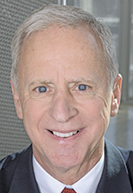Subscriber Benefit
As a subscriber you can listen to articles at work, in the car, or while you work out. Subscribe NowPrior to the personal injury case going to trial, plaintiff attorney Ann Marie Waldron and her colleagues recounted the facts to groups of people at parties and informal gatherings.
The team — lead counsel Waldron, Michael Simmons, senior partner at Hume Smith Geddes Green & Simmons LLP and Robert P. Thomas — detailed the drunk driving accident that left their client, Gregory Smith, 32, a quadriplegic, and battling the insurance company for compensation to cover his medical expenses and continued care. The responses varied greatly, but the discussions helped the attorneys develop their strategy once they were in the courtroom.
At trial, the plaintiff’s attorneys put experts on the stand who calculated the costs of his care and explained the medical complications he would face over his lifetime. Their work paid off, as the Marion County jury returned a $35 million verdict against the defendant in Gregory Smith v. Nolan Clayton, 49D14-1606-CT-021431. This is believed to be one of the largest personal injury judgments in Indianapolis.
Waldron, like other trial lawyers, noted these verdicts provide important quality of life for the injured. She called it “money justice,” explaining justice would be her client walking again. Since that is unlikely, the money will make his life a little easier.
“It’s not the final dollar amount that is important,” Waldron said. “It’s how the dollar amount affects your client.”
High dollars, big impacts
 Christie
ChristieLee Christie, partner at Cline Farrell Christie & Lee P.C., also received a big verdict of $30.5 million, representing an electrician who broke his neck while working.
He noted jurors are increasingly less offended by requests for million-dollar-plus verdicts. Christie speculated that the shock of big money was muted by seemingly daily news about lottery jackpots, athlete contracts and CEO compensation.
The largest jury verdict in Indiana was $157 million in 2009 in a Tippecanoe Superior Court product liability case, according to The Indiana Jury Verdict Reporter. The widow of Timothy Simonton, represented by the Ken Nunn Law Office, brought a lawsuit against the manufacturers after a tree stand malfunctioned and the safety cord strangled him while he was hunting. She had sought $6,000 for funeral expenses and $1.5 million for lost wages.
Personal injury attorney Kenneth J. Allen got a $48 million verdict for a worker who was paralyzed after falling off a ladder at a steel mill. He maintained high-dollar verdicts benefit more than the plaintiff.
 Allen
Allen“The true purpose of this law is to make things safer and better for people,” he explained. “Obviously it wants to compensate people for what they’re going through and going to go through, but the fundamental purpose of tort law is to make things safer.”
As an example, he pointed to the $18.5 million verdict he secured against the trucking company Celadon Group, Inc., after a 2011 accident that killed two people. The company, according to Allen, had been incentivizing its drivers to use cruise control to save on fuel costs. As a result of the verdict, Celadon changed its policy.
Robert Thornburg, president of the Defense Trial Counsel of Indiana, pointed out big verdicts are uncommon in Indiana. Hoosier juries, he said, tend to be reasonable, give compensation for people’s injuries, but do not render awards that “make people scratch their heads and say what happened.”
Hot coffee
Plaintiff attorneys say they have to overcome the McDonald’s hot coffee case.
In 1992, a Texas woman was awarded nearly $3 million after spilling her coffee and suffering third-degree. The case was held up to underscore the problem of frivolous lawsuits. However, McDonald’s admitted to knowing the temperature of its coffee could cause serious burns and others had been scalded, but the restaurant did not warn customers or turn down the heat.
Christie keeps a fact sheet on the case handy to review with his clients. He particularly points out that the woman and McDonalds ultimately settled for a lesser amount.
The attorney wants his clients to understand they may not be able to recover much for their injuries. A jury might render a multi-million-dollar verdict, but the actual payout might be reduced to the limit of the insurance policy or the defendant might declare bankruptcy.
Waldron and her colleagues are trying to secure the full $35 million for Smith. Shortly after the verdict, Marion Superior Judge Timothy Oakes ruled in a companion lawsuit that Progressive Insurance has a duty to pay the jury award.
Also, the plaintiff’s team is working to enhance the amount through additional claims, arguing Progressive could have settled.
Trusting in jurors
Allen noted the McDonald’s case contributes to an “anti-plaintiff” attitude. He overcomes that bias by being candid, respecting the jurors’ time, and being well-prepared. In 25 years, Allen has not lost a case in state court and he has come to trust the “computing power in the jury box.”
Thornburg, member at Frost Brown Todd, agreed with Allen that jurors work hard and are diligent about their duties. Defense counsel, he said, can acknowledge the plaintiff has suffered and can express sympathy, but the goal is to keep the jury focused on applying the law to the facts of the case.
“I really think our jury system and legal system is probably the best in the world for resolving disputes,” he said. “The collective wisdom the jurors bring to a case is sometimes really impressive.”•
Please enable JavaScript to view this content.
